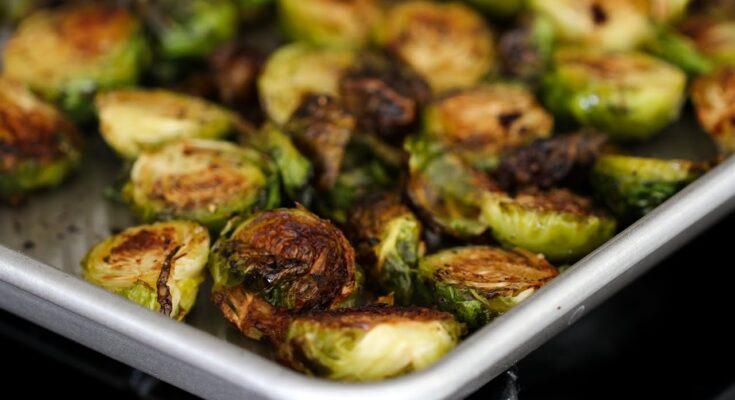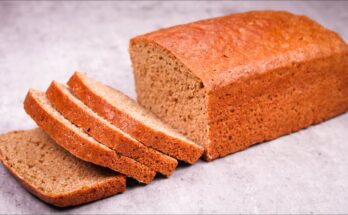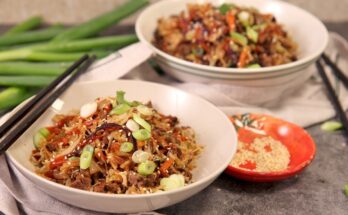Balsamic Brussel Sprouts Recipe: Brussels sprouts have long been underrated, but when cooked the right way, they can transform from a simple vegetable into a show-stopping dish. One of the best ways to bring out their natural sweetness and earthy flavor is by roasting them with olive oil and finishing them off with a rich balsamic glaze. The result? Crispy, caramelized Brussels sprouts that are savory, tangy, and slightly sweet.
This guide will walk you through everything you need to know to prepare the perfect balsamic Brussels sprouts recipe at home. From the ingredients you’ll need to the step-by-step cooking process, plus expert tips for getting the crispiest edges, you’ll have a dish that’s perfect for weeknight dinners, holiday feasts, or even as a healthy snack.
Why Brussels Sprouts Are a Must-Try Side Dish
Brussels sprouts are small, leafy green vegetables that belong to the cabbage family. While they may have gained a bad reputation in the past for being bitter, modern cooking techniques have completely changed how we enjoy them. Roasting Brussels sprouts in the oven brings out their natural sweetness, softens their centers, and gives them a crispy, golden-brown exterior that’s incredibly satisfying.
They’re also a versatile side dish. Whether you’re serving them alongside roasted chicken, a juicy steak, or even a holiday turkey, they add both flavor and nutrition to your meal. What makes them extra special is that they absorb seasonings beautifully, which means you can experiment with flavors to suit your taste.
The Magic of Balsamic Glaze
What sets this recipe apart is the addition of balsamic vinegar—or better yet, balsamic glaze. Balsamic vinegar is known for its deep, tangy flavor with a hint of natural sweetness. When reduced into a glaze, it becomes thick, syrupy, and slightly sweet, making it the perfect finishing touch for roasted vegetables.
When drizzled over hot, crispy Brussels sprouts, balsamic glaze enhances the dish with a balance of tangy and sweet notes. It cuts through the earthiness of the sprouts and elevates them into something gourmet. The glaze clings to each leaf, making every bite a burst of flavor.
Ingredients You’ll Need
The beauty of this recipe is its simplicity. With just a few basic ingredients, you can create a dish that looks and tastes like it came from a restaurant kitchen.
Fresh Brussels Sprouts
Start with fresh, firm Brussels sprouts. Look for ones that are bright green, tightly packed, and about the same size for even cooking. Smaller sprouts tend to be sweeter and less bitter than larger ones, but either will work as long as they’re fresh.
Before cooking, trim off the stem ends and remove any yellow or damaged leaves. Cutting the sprouts in half lengthwise will help them roast more evenly and give you more surface area for that crispy caramelization.
Olive Oil for Roasting
Olive oil is essential in this recipe. It not only helps the Brussels sprouts roast evenly but also enhances their flavor and helps them achieve that beautiful golden-brown crust. Extra-virgin olive oil is the best choice, but you can also use avocado oil or vegetable oil if that’s what you have on hand.
Balsamic Vinegar and Glaze
You can use regular balsamic vinegar and reduce it into a glaze yourself, or you can buy pre-made balsamic glaze from the store. Both options work well. If you’re making your own glaze, simply simmer balsamic vinegar until it thickens into a syrup. This gives you control over the flavor and thickness, but store-bought glaze is a quick and convenient alternative.
Optional Add-Ins (Garlic, Parmesan, Nuts, Bacon)
This recipe is fantastic on its own, but you can take it to the next level with some optional add-ins:
- Garlic – Minced garlic adds a wonderful aroma and a savory depth.
- Parmesan cheese – Sprinkle freshly grated Parmesan on top right before serving for a salty, nutty flavor.
- Nuts – Toasted almonds, walnuts, or pecans can add crunch and richness.
- Bacon – Crispy bacon pieces pair beautifully with the tangy balsamic glaze.
Kitchen Tools You’ll Need
Before diving into the cooking process, let’s make sure you have the right tools on hand. These simple kitchen essentials will make the recipe easy to prepare.
Baking Sheet and Parchment Paper
A large baking sheet is crucial for roasting Brussels sprouts. Spread them out evenly so they have space to crisp up instead of steaming. Lining the sheet with parchment paper or foil makes cleanup easier and helps prevent sticking.
Mixing Bowls
A couple of mixing bowls will help you toss the sprouts with oil and seasonings. Use a large one so you have enough room to coat the sprouts evenly.
Measuring Cups and Spoons
While this recipe doesn’t require precise measurements, it’s still helpful to have measuring tools handy to ensure you don’t go overboard with the oil or vinegar. Balance is key for getting the flavors just right.
Step-by-Step Guide to Making Balsamic Brussels Sprouts
Now that you have your ingredients and tools ready, it’s time to cook. This step-by-step guide will take you through the entire process, ensuring your Brussels sprouts turn out perfectly every time.
Step 1 – Prepping the Brussels Sprouts
Start by washing the Brussels sprouts thoroughly under cold water. Trim off the stem ends and peel away any loose or discolored outer leaves. Then, cut each sprout in half lengthwise. This not only helps them cook faster but also gives you those crispy edges we all love.
If your sprouts are particularly large, you may want to quarter them instead. Just make sure they’re all roughly the same size so they roast evenly.
Step 2 – Seasoning and Tossing with Oil
Once your Brussels sprouts are trimmed and halved, it’s time to season them. Place them in a large mixing bowl and drizzle with olive oil. You don’t need a lot—just enough to lightly coat each sprout. A tablespoon or two usually does the trick, depending on the amount you’re making.
After adding the oil, season generously with salt and freshly cracked black pepper. Toss everything together with your hands or a large spoon until the sprouts are evenly coated. The oil ensures they roast to perfection, while the salt and pepper bring out their natural flavor.
If you’re using garlic, nuts, or other add-ins, you can mix them in at this stage as well. Keep in mind, garlic tends to burn quickly, so if you want a milder flavor, add it halfway through roasting instead of at the beginning.
The key here is balance—you don’t want too much oil, or your sprouts will turn soggy. Just enough to create a thin coating is perfect for achieving crispy edges.
Step 3 – Roasting to Crispy Perfection
This is where the magic happens. Preheat your oven to 400°F (200°C). Spread the Brussels sprouts out in a single layer on your lined baking sheet. Make sure they’re cut side down for maximum caramelization.
Roast for about 20–25 minutes, flipping them once halfway through. The exact timing depends on the size of your sprouts and your oven, but you’re looking for golden-brown, crispy edges and tender centers.
Don’t overcrowd the pan—this is one of the biggest mistakes people make when roasting vegetables. If they’re too close together, they’ll steam instead of roast, leaving you with soft sprouts instead of crispy ones. If necessary, use two baking sheets to give them enough space.
By the time they’re done, your kitchen will smell incredible. The sprouts should look slightly charred on the outside, which is exactly what you want. That caramelization is what gives them their irresistible flavor.
Step 4 – Drizzling with Balsamic Glaze
Once your sprouts are out of the oven, it’s time to add the star ingredient: balsamic glaze. If you’re using store-bought glaze, drizzle it directly over the hot sprouts. If you made your own reduction, make sure it has cooled slightly so it’s thick but still pourable.
Start with a light drizzle and toss the sprouts gently to coat them. You don’t want to drown them in glaze—it’s meant to enhance, not overpower. The glaze will cling to the crispy leaves and add that sweet-tangy burst of flavor in every bite.
At this point, you can also sprinkle on some grated Parmesan, toasted nuts, or crispy bacon if you’re adding extras. The combination of textures and flavors makes the dish truly unforgettable.
Step 5 – Adding Final Touches
Presentation matters, especially if you’re serving these Brussels sprouts at a holiday dinner or special gathering. Transfer the roasted sprouts to a serving dish and finish with a sprinkle of flaky sea salt for a final layer of flavor.
If you’re aiming for a restaurant-style touch, add a light garnish of fresh herbs like parsley or thyme. This not only makes the dish look beautiful but also adds a fresh note that balances the richness of the balsamic glaze.
Serve the sprouts immediately while they’re still hot and crispy. They pair wonderfully with roasted meats, grilled fish, or even vegetarian mains like risotto or pasta.
Tips for Perfect Brussels Sprouts
Now that you know the steps, let’s talk about how to make them absolutely perfect every single time.
How to Get Crispy Edges
- Always cut the sprouts in half and place them cut side down.
- Make sure your oven is fully preheated before roasting.
- Don’t skimp on the oil—it’s essential for crispiness.
- Use high heat (400°F or higher) for the best caramelization.
Avoiding Soggy Brussels Sprouts
- Don’t overcrowd the pan. Spread them out in a single layer.
- Pat the sprouts dry after washing them to remove excess moisture.
- Flip them halfway through roasting so they crisp evenly.
Flavor Variations to Try
- Honey Balsamic – Add a teaspoon of honey to your balsamic glaze for extra sweetness.
- Spicy Brussels Sprouts – Toss with a pinch of red pepper flakes before roasting.
- Asian-Inspired – Use sesame oil instead of olive oil and finish with a splash of soy sauce.
- Cheesy Delight – Add a handful of shredded mozzarella or Parmesan at the end and broil for 2 minutes until melted and bubbly.
With these tips, you’ll never end up with bland or soggy sprouts again. Instead, you’ll have a side dish that even the pickiest eaters can’t resist.
Serving Suggestions
Brussels sprouts with balsamic glaze are versatile and can complement a wide variety of meals. Whether you’re making them for a weeknight dinner or a festive holiday feast, they’ll shine on the table.
As a Holiday Side Dish
During Thanksgiving, Christmas, or Easter, these balsamic Brussels sprouts make an elegant and flavorful side. They balance out rich dishes like mashed potatoes, stuffing, and gravy with their tangy sweetness. Plus, they add a pop of green to your holiday spread, making the table look more vibrant and inviting.
Pairing with Proteins
Brussels sprouts pair beautifully with both meats and plant-based proteins. Serve them with roasted chicken, grilled salmon, or a juicy steak for a well-rounded meal. If you’re vegetarian, try pairing them with lentils, quinoa, or a hearty mushroom dish. Their bold flavor ensures they won’t get lost next to stronger mains.
As a Healthy Snack
Believe it or not, roasted Brussels sprouts can also be a snack! Their crispy leaves make them almost like veggie chips. You can roast a batch, drizzle with balsamic, and enjoy them straight off the pan as a guilt-free, nutrient-packed snack.
Nutritional Benefits of Brussels Sprouts
One of the best things about this recipe is that it’s as healthy as it is delicious. Brussels sprouts are a nutritional powerhouse packed with essential vitamins, minerals, and antioxidants.
Packed with Vitamins and Minerals
Brussels sprouts are rich in vitamin C, which supports your immune system, and vitamin K, which is essential for bone health. They also contain folate, manganese, and potassium—nutrients that help with everything from energy production to heart health.
High in Fiber and Low in Calories
If you’re looking for a nutrient-dense, low-calorie side dish, Brussels sprouts are perfect. One cup of cooked Brussels sprouts contains only about 38 calories but provides 3–4 grams of fiber. This makes them great for digestion and helps you feel full longer.
Antioxidants and Heart Health
Brussels sprouts contain compounds called glucosinolates, which have antioxidant properties that may help protect against chronic diseases. Their high fiber content also helps lower cholesterol levels, supporting better heart health.
So when you enjoy balsamic Brussels sprouts, you’re not only treating your taste buds—you’re nourishing your body too.
Storing and Reheating Leftovers
If you have leftovers (which is rare because they’re so delicious!), you’ll want to store them properly to keep their flavor and texture intact.
Best Storage Methods
Allow the sprouts to cool completely before transferring them to an airtight container. Store them in the refrigerator for up to 3–4 days. Avoid leaving them uncovered in the fridge, as they’ll dry out and lose flavor.
How to Reheat without Losing Crispiness
The best way to reheat Brussels sprouts is in the oven or air fryer. Preheat the oven to 375°F (190°C), spread the sprouts on a baking sheet, and heat for about 8–10 minutes until warmed through and crispy again. If you’re short on time, you can use the microwave, but keep in mind they’ll lose some of their crunch.
Pro tip: Add a fresh drizzle of balsamic glaze right before serving to bring them back to life.
Common Mistakes to Avoid
Even though this recipe is simple, a few common mistakes can make the difference between soggy sprouts and crispy perfection.
Overcrowding the Pan
If the sprouts are packed too tightly on the baking sheet, they’ll steam instead of roast. Always give them enough space to crisp up.
Using Too Much Oil
While oil is essential, too much of it will make the sprouts greasy and heavy. A light coating is all you need.
Skipping the Balsamic Glaze
Some people roast Brussels sprouts and forget the glaze, but that’s what makes this recipe special. The balsamic glaze adds depth and sweetness that takes the dish to another level.
By avoiding these pitfalls, you’ll get perfectly roasted sprouts every single time.
FAQs about Balsamic Brussel Sprouts Recipe
Q1: Can I make this recipe in an air fryer instead of the oven?
Yes! Simply toss the Brussels sprouts with oil and seasonings, then air fry at 375°F for 12–15 minutes, shaking the basket halfway through. They’ll come out extra crispy.
Q2: What’s the difference between balsamic vinegar and balsamic glaze?
Balsamic vinegar is liquid and tangy, while balsamic glaze is a thicker, sweeter reduction of vinegar. You can make your own glaze by simmering balsamic vinegar until it reduces.
Q3: Can I prepare these in advance for a party?
You can roast the sprouts ahead of time and store them in the fridge. Just reheat in the oven before serving and add the balsamic glaze right before bringing them to the table.
Q4: Do Brussels sprouts taste bitter?
When overcooked, Brussels sprouts can taste bitter. Roasting them at high heat caramelizes their natural sugars, giving them a sweeter and nuttier flavor.
Q5: Can I freeze roasted Brussels sprouts?
Freezing is not recommended because they lose their texture and become mushy when reheated. It’s best to enjoy them fresh.
Conclusion
Balsamic Brussels sprouts are proof that simple ingredients can create an extraordinary dish. With just a few steps—trimming, seasoning, roasting, and drizzling—you’ll have a flavorful side that’s crispy, tangy, and downright addictive. Whether you’re cooking for your family, entertaining guests, or preparing a holiday feast, this recipe is guaranteed to impress.
So the next time you’re looking for a side dish that’s both healthy and delicious, give these balsamic Brussels sprouts a try. You might just convert a few sprout skeptics into lifelong fans!



